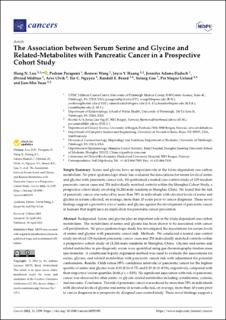| dc.contributor.author | Luu, Hung N. | |
| dc.contributor.author | Paragomi, Pedram | |
| dc.contributor.author | Wang, Renwei | |
| dc.contributor.author | Huang, Joyce Y. | |
| dc.contributor.author | Adams-Haduch, Jennifer | |
| dc.contributor.author | Midttun, Øivind | |
| dc.contributor.author | Ulvik, Arve | |
| dc.contributor.author | Nguyen, Tin C. | |
| dc.contributor.author | Brand, Randall E. | |
| dc.contributor.author | Gao, Yutang | |
| dc.contributor.author | Ueland, Per Magne | |
| dc.contributor.author | Yuan, Jian-Min | |
| dc.date.accessioned | 2022-10-05T10:42:38Z | |
| dc.date.available | 2022-10-05T10:42:38Z | |
| dc.date.created | 2022-05-12T17:03:41Z | |
| dc.date.issued | 2022-04-28 | |
| dc.identifier.issn | 2072-6694 | |
| dc.identifier.uri | https://hdl.handle.net/11250/3024010 | |
| dc.description.abstract | Background: Serine and glycine play an important role in the folate-dependent one-carbon metabolism. The metabolism of serine and glycine has been shown to be associated with cancer cell proliferation. No prior epidemiologic study has investigated the associations for serum levels of serine and glycine with pancreatic cancer risk.
Methods: We conducted a nested case-control study involved 129 incident pancreatic cancer cases and 258 individually matched controls within a prospective cohort study of 18,244 male residents in Shanghai, China. Glycine and serine and related metabolites in pre-diagnostic serum were quantified using gas chromatography-tandem mass spectrometry. A conditional logistic regression method was used to evaluate the associations for serine, glycine, and related metabolites with pancreatic cancer risk with adjustment for potential confounders.
Results: Odds ratios (95% confidence intervals) of pancreatic cancer for the highest quartile of serine and glycine were 0.33 (0.14–0.75) and 0.25 (0.11–0.58), respectively, compared with their respective lowest quartiles (both p’s < 0.01). No significant association with risk of pancreatic cancer was observed for other serine- or glycine related metabolites including cystathionine, cysteine, and sarcosine.
Conclusion: The risk of pancreatic cancer was reduced by more than 70% in individuals with elevated levels of glycine and serine in serum collected, on average, more than 10 years prior to cancer diagnosis in a prospectively designed case-control study. These novel findings support a protective role of serine and glycine against the development of pancreatic cancer in humans that might have an implication for cancer prevention. | en_US |
| dc.language.iso | eng | en_US |
| dc.publisher | MDPI | en_US |
| dc.rights | Navngivelse 4.0 Internasjonal | * |
| dc.rights.uri | http://creativecommons.org/licenses/by/4.0/deed.no | * |
| dc.title | The Association between Serum Serine and Glycine and Related-Metabolites with Pancreatic Cancer in a Prospective Cohort Study | en_US |
| dc.type | Journal article | en_US |
| dc.type | Peer reviewed | en_US |
| dc.description.version | publishedVersion | en_US |
| dc.rights.holder | Copyright 2022 the authors | en_US |
| dc.source.articlenumber | 2199 | en_US |
| cristin.ispublished | true | |
| cristin.fulltext | original | |
| cristin.qualitycode | 1 | |
| dc.identifier.doi | 10.3390/cancers14092199 | |
| dc.identifier.cristin | 2024055 | |
| dc.source.journal | Cancers | en_US |
| dc.identifier.citation | Cancers. 2022, 14 (9), 2199. | en_US |
| dc.source.volume | 14 | en_US |
| dc.source.issue | 9 | en_US |

